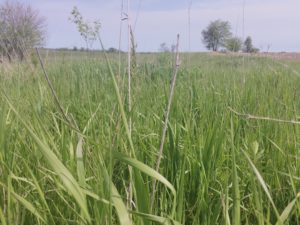Heirloom seeds. What are they?
Heirloom seeds are seeds that have been passed down through several generations and carry the traits of the parent plant. They are grown to preserve plant diversity and deviates from the uniformity of plants that are produced for commodity. Heirloom seeds are intended to track the heritage of the seed. Neat right?
This is truly where narrative and farming meet. The importance of each seed can be measured by both it’s genetic traits and by the story it can tell simultaneously. Who planted this seed? Where did it come from? Did it immigrate over oceans and mountains? Who did it feed? How does it grow now? These are all the questions that the plant could answer.
I learned about these specialty seeds at the organization, Practical Farmers of Iowa, because of Steve Carlson and his passion for the seeds. After leaving I could not stop thinking about them. I just became fascinated about all the many historical secrets that the seeds hold, and what unlocking them would look like. Well initially, I was thinking about writing historical logs for the different kinds of seeds and creating cool little profiles for them in database, but then I realized that this idea actually already kind of exist because of seed banks that hold heirloom seeds. Today though, I got a chance to see heirloom seeds in action. We visited the Neal Smith National Wildlife Refuge. This refuge falls under the US Fish and Wildlife Services and here in Iowa they have focused a lot attention on restoring parts of Iowa to it native habitat, prairie!
The indigenous lands of Iowa were covered for miles and miles of tall grass prairie lands and some plants have the capacity to grow up to ten feet tall. One reason the refuge has taken so much time to study and restore the lands was because prairie actually works as a great tool to reduce field run-off of top soil and different pesticides that are used on fields. On our tour of the prairie one of our guides asked us to imagine what the land would have looked like before the European settlers came, to the now state of Iowa. I loved this comment because it gave recognition to the lost land of Native Americans and also recognizes some of the lasting effects of colonization. Even though the prairie lands probably don’t exactly count as heirloom seeds, one can understand how conservation and agricultural diversity go hand in hand. The conservation literally brings history to life, they show how the land used to be. Not only do they restore the plants, but they restore the wildlife bringing some of the first inhabitants of the land. The gateway between the conservation efforts, environmental protections, and of historical reckoning is amazing (the best of three worlds).
I want to begin to investigate and this heirloom seed could be used to study the history of American slavery. When I imagine this research I imagine the results could function as a way to connect the painful history of slavery and how that affects how young Black adults view agriculture as a profession. Also maybe heirloom seeds could function as a form of reparations; tracing the genetics of cash crops and produce crops to specific regions in America and giving descendants of slaves the opportunity to buy a share in cotton stocks, tobacco, rice, or sugarcane. This would definitely start shifting agricultural dynamics.
Heirloom seeds. What are they? Plant heritage, history books, prairie fields, and justice.

